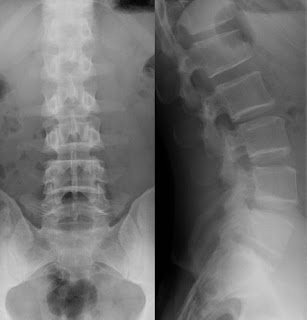The other day I read about the American College of Physicians recent updated recommendations concerning ordering routine scans such as x rays and MRI for back pain (http://www.nytimes.com/2011/02/15/health/research/15screening.html).
 The study states "Routinely ordering X-rays and CT orM.R.I. scans drives up health care costs, and does not help resolve the problem, the college’s “best practice advice” guidelines say. On the contrary, the guidelines suggest, the scans may pick up unrelated abnormalities, leading to additional tests or procedures that are of no benefit, and some scans expose patients to high levels of radiation. The recommendations are the first in a series of papers aimed at helping doctors and patients identify misused medical treatments."
The study states "Routinely ordering X-rays and CT orM.R.I. scans drives up health care costs, and does not help resolve the problem, the college’s “best practice advice” guidelines say. On the contrary, the guidelines suggest, the scans may pick up unrelated abnormalities, leading to additional tests or procedures that are of no benefit, and some scans expose patients to high levels of radiation. The recommendations are the first in a series of papers aimed at helping doctors and patients identify misused medical treatments."
On one hand, I totally agree because many physicians who do not have good evaluation skills for lower back problems will rely on scans that can be expensive in the case of an MRI or CT scan, and the tests either come back negative or show a lesion that may have nothing to do at all with why the person is in pain. A proper evaluation is essential, and requires more than just feeling the muscles, checking reflexes and doing a straight leg raise test, which we are taught in school to do. Many of the newer doctors who specialize in physical medicine such as chiropractors are now using active evaluation methods which tell us much more about what is going on functionally. We can then use a standing lumbar xray to deduce the overall condition of the structures. Unlike many doctors who order lower back films taken on a table, standing films yield more useful information because it shows posture (a component of lower back pain in many cases), alignment as well as other useful information such as the quality of the hip sockets (which can be problematic in older patients).
The big question of course is when is it appropriate. In our office, we typically do not taken plain films in children under 18, unless trauma was involved. Over 18, if I deduce there was trauma or recurrent injuries, films are indicated to determine where the injuries occured and to what extent. Most people over the mid 30's on will likely be candidates for x rays films with trauma or if the problem is recurrent. While we do not perform blanket screenings, the use of plain films is quite helpful, especially in the chiropractic office since we are performing manual work and the films also alert us to anomalies. Recently, an older patient we took films on looked to have a slight curvature in his back. The films showed the curve to be over 30 degrees which is quite significant and alters the way we would treat him. Obviously, this gives us medical necessity.
The article continues by saying "Most lower back pain is caused by strain on bones, muscles and ligaments. It can be treated with over-the-counter painkillers and usually abates within a few days, said an author of the practice guidelines, Dr. Amir Qaseem, director of clinical policy in medical education at the American College of Physicians." Personally, I think this shows the typical lack of true knowledge of what back pain is and why most people are not helped. Pain killers may hide the pain, however, they never fix the body mechanics that create the problem. When you teach legions of primary care doctors that this is what back pain is, which is what typically happens, you get poor patient satisfaction, mediocre outcomes and people developing chronic back problems.
Lower back pain, especially chronic problems, most commonly start at the feet. The more asymmetrical or inefficient your body is designed, the more you tend to suffer from back problems. Our patients know this because they see the results we get, and the way we are able to demonstrate to them where the problems are coming from and how quickly we often can turn these problems around. To dismiss this as strain on bones, muscles and ligaments ignores that all structures against gravity experience this. Not all structures have pain. It is when these structures are overloaded by asymmetrical forces that the back breaks down and joints are damaged. This is why we rarely perform tests such as MRI because
1. most people improve from our care and not only feel better but function better too.
2. Those who do not improve after a reasonable course of care (2-3 weeks) are then referred for MRI or other advanced scans. Since most people improve, few scans are ordered.
This is my opinion based on many years of experience. Of course, I value your opinion too. You can email any questions to backfixer@aol.com
 The study states "Routinely ordering X-rays and CT orM.R.I. scans drives up health care costs, and does not help resolve the problem, the college’s “best practice advice” guidelines say. On the contrary, the guidelines suggest, the scans may pick up unrelated abnormalities, leading to additional tests or procedures that are of no benefit, and some scans expose patients to high levels of radiation. The recommendations are the first in a series of papers aimed at helping doctors and patients identify misused medical treatments."
The study states "Routinely ordering X-rays and CT orM.R.I. scans drives up health care costs, and does not help resolve the problem, the college’s “best practice advice” guidelines say. On the contrary, the guidelines suggest, the scans may pick up unrelated abnormalities, leading to additional tests or procedures that are of no benefit, and some scans expose patients to high levels of radiation. The recommendations are the first in a series of papers aimed at helping doctors and patients identify misused medical treatments."On one hand, I totally agree because many physicians who do not have good evaluation skills for lower back problems will rely on scans that can be expensive in the case of an MRI or CT scan, and the tests either come back negative or show a lesion that may have nothing to do at all with why the person is in pain. A proper evaluation is essential, and requires more than just feeling the muscles, checking reflexes and doing a straight leg raise test, which we are taught in school to do. Many of the newer doctors who specialize in physical medicine such as chiropractors are now using active evaluation methods which tell us much more about what is going on functionally. We can then use a standing lumbar xray to deduce the overall condition of the structures. Unlike many doctors who order lower back films taken on a table, standing films yield more useful information because it shows posture (a component of lower back pain in many cases), alignment as well as other useful information such as the quality of the hip sockets (which can be problematic in older patients).
The big question of course is when is it appropriate. In our office, we typically do not taken plain films in children under 18, unless trauma was involved. Over 18, if I deduce there was trauma or recurrent injuries, films are indicated to determine where the injuries occured and to what extent. Most people over the mid 30's on will likely be candidates for x rays films with trauma or if the problem is recurrent. While we do not perform blanket screenings, the use of plain films is quite helpful, especially in the chiropractic office since we are performing manual work and the films also alert us to anomalies. Recently, an older patient we took films on looked to have a slight curvature in his back. The films showed the curve to be over 30 degrees which is quite significant and alters the way we would treat him. Obviously, this gives us medical necessity.
The article continues by saying "Most lower back pain is caused by strain on bones, muscles and ligaments. It can be treated with over-the-counter painkillers and usually abates within a few days, said an author of the practice guidelines, Dr. Amir Qaseem, director of clinical policy in medical education at the American College of Physicians." Personally, I think this shows the typical lack of true knowledge of what back pain is and why most people are not helped. Pain killers may hide the pain, however, they never fix the body mechanics that create the problem. When you teach legions of primary care doctors that this is what back pain is, which is what typically happens, you get poor patient satisfaction, mediocre outcomes and people developing chronic back problems.
Lower back pain, especially chronic problems, most commonly start at the feet. The more asymmetrical or inefficient your body is designed, the more you tend to suffer from back problems. Our patients know this because they see the results we get, and the way we are able to demonstrate to them where the problems are coming from and how quickly we often can turn these problems around. To dismiss this as strain on bones, muscles and ligaments ignores that all structures against gravity experience this. Not all structures have pain. It is when these structures are overloaded by asymmetrical forces that the back breaks down and joints are damaged. This is why we rarely perform tests such as MRI because
1. most people improve from our care and not only feel better but function better too.
2. Those who do not improve after a reasonable course of care (2-3 weeks) are then referred for MRI or other advanced scans. Since most people improve, few scans are ordered.
This is my opinion based on many years of experience. Of course, I value your opinion too. You can email any questions to backfixer@aol.com

No comments:
Post a Comment
Thankyou for your comments on my posting.
Dr. C
Note: Only a member of this blog may post a comment.